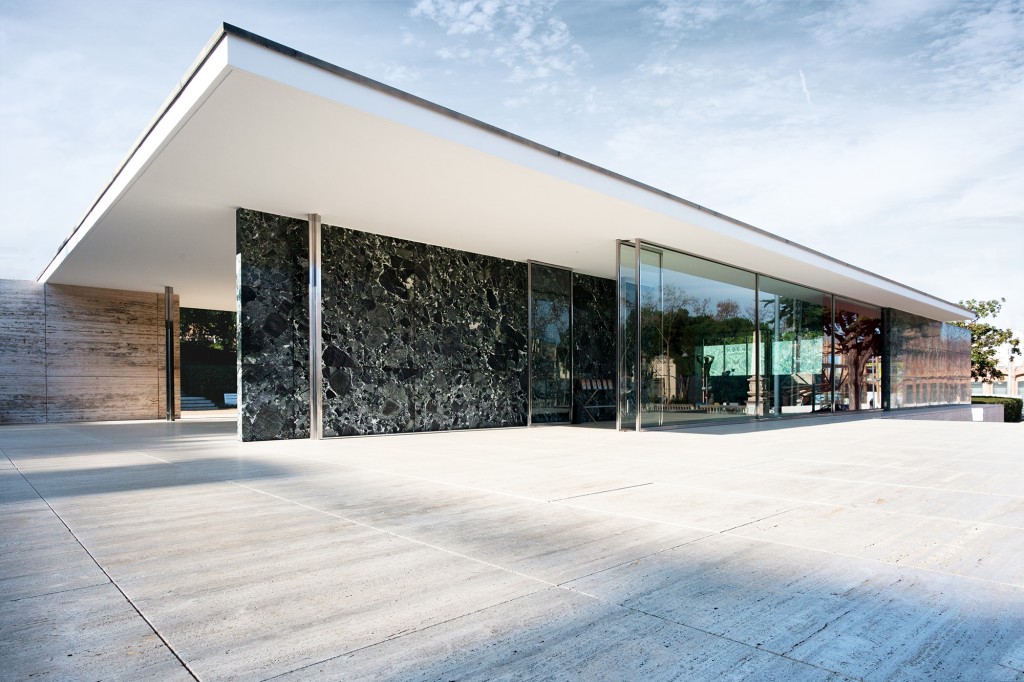Ludwig Mies van der Rohe, (1886 – 1969) worked as an architect, like many of the famous designers of the 20th century and is well known for his designs of exhibition pavilions and his chairs received the most attention and acclaim.
A modernist Classic: the Barcelona Pavilion


The Barcelona Pavilion was the German Pavilion for the 1929 International Exposition in Barcelona, Spain. This building was used for the official opening of the German section of the exhibition. It is an important building in the history of modern architecture, known for its simple form and its spectacular use of extravagant materials, such as marble, red onyx and travertine. The same features of minimalism and spectacular can be applied to the prestigious furniture specifically designed for the building, among which the iconic Barcelona chair. It has inspired many important modernist buildings, including Michael Manser’s Capel Manor House in Kent.
The pavilion was to be bare, with no exhibits, leaving only the structure accompanying a single sculpture and specially-designed furniture (the Barcelona Chair). This lack of accommodation enabled Mies to treat the Pavilion as a continuous space; blurring inside and outside.
The design was an absolution distinction between structure and enclosure—a regular grid of cruciform steel columns interspersed by freely spaced planes. A hybrid style structure, where some planes also served as support. The entire building rests on a plinth of travertine. A southern U-shaped enclosure, also of travertine, helps form a service annex and a large water basin. The floor slabs of the pavilion project out and over the pool—once again connecting inside and out. Another U-shaped wall on the opposite side of the site also forms a smaller water basin. The roof plates, relatively small, are supported by the chrome-clad, cruciform columns: a hoovering roof. Another unique feature of this building is the exotic materials Mies chooses to use. Plates of high-grade stone materials like veneers of Tinos verde antico marble and golden onyx as well as the tinted glass of grey, green, white, as well as translucent glass, perform exclusively as spatial dividers.
On the ‘naked’ eye the Pavilion doesn’t seem to have much to do with technology, however from Mies van der Rohe’s writings it is clear that the relation of architecture and technology played an important part in his studies and designs: ‘Wherever technology reaches its real fulfillment, it transcends into architecture.’
Mies wanted this building to become ‘an ideal zone of tranquillity’ for the visitors. Since the pavilion lacked a real exhibition space, the building itself was to become the exhibit. The walls not only created space but also directed visitor’s movements. This was achieved by wall surfaces being displaced against each other, running past each other, and creating a space that became narrower or wider. The wall planes do not follow the typical ‘load-bearing function’, they are independent of supporting columns and/ or the roof plane. Technology makes the spatial continuity possible.
Mies used technology to ‘transcend into architecture.’ For instance, the Barcelona Chairs, designed by Ludwig Mies van der Rohe and Lilly Reich specifically for the Pavilion in 1929, required advanced technology of metal bending and chrome plating. Quoting Mies, it had to be an ‘important chair, a very elegant chair.’ ‘The government was to receive a king…The chair had to be… monumental. In those circumstances, you just couldn’t use a kitchen chair.’ Another unique feature of this building is the exotic materials Mies chooses to use. Plates of high-grade stone materials like veneers of Tinos verde antico marble and golden onyx as well as tinted glass of grey, green, white, as well as translucent glass, perform exclusively as spatial dividers: engineered, precisely cut system of panels, with each material following its own grid, where the grids do not always align.
‘God is in the details’
